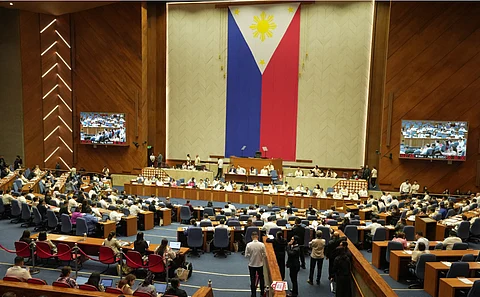
- NEWS
- the EDIT
- COMMENTARY
- BUSINESS
- LIFE
- SHOW
- ACTION
- GLOBAL GOALS
- SNAPS
- DYARYO TIRADA
- MORE

Administration lawmakers on Friday backed President Marcos Jr.’s directive to open the bicameral conference committee for the P6.793-trillion proposed 2026 budget, ditching Congress’ longstanding practice of crafting the final draft of the spending bill away from public scrutiny.
However, a minority leader dismissed such a move as a mere performative act to placate the public’s frustrations towards the administration in the wake of alleged rampant corruption linked to the flood control projects, which were heavily blamed on the bicam in the previous Congress.
“It doesn’t automatically become transparent just because it’s livestreamed. There [are] a lot of things that happen behind the scenes, and essentially, what we see in the livestream is what they want us to see," ACT Teachers Rep. Antonio Tinio said in an interview on Friday.
Deputy Speakers Jefferson Khonghun and Paolo Ortega and House Committee on Appropriations vice chair Zia Adiong strongly posit that livestreaming the bicam promotes public participation in the crucial budget process, rejects secrecy, and prevents the recurrence of manipulation, as was the case with this year’s budget.
“The public has every right to see where their taxes go, and livestreaming the bicameral conference delivers on that promise,” their joint statement read.
Earlier this week, the President declared to livestream the bicam deliberations for the 2026 budget and dismantle the so-called small committee to “encourage transparency.”
This indicates that the general public would have access to the entire bicam process, the last stage where amendments to the final version of the General Appropriations Bill are made, before the measure is transmitted to Malacanang for the President’s signature.
The bicam comprises selected members of the House and the Senate, tasked with reconciling the diverging provisions of their respective versions of the bill.
Marcos said this would make no room for “questionable” last-minute insertions, and the proponents would be clearly identified.
Opening the bicam to the public was among the key reforms implemented by former House speaker Martin Romualdez before stepping down from the post in early September. The chamber also abolished the small committee, deemed a secretive enclave for last-minute insertions.
The move follows the clamor of budget watchdogs, who flagged the 2025 GAA for bloated unprogrammed appropriations (UA) intended to bankroll infrastructure projects, while allocations and subsidies for the education sector and state insurer PhilHealth, respectively, suffered deep cuts.
Despite the administration's bold move to purge potential corruption in next year’s budget, Tinio cast doubt on the effort, pointing out that the public might not get full access to the full details, as seen in the House Budget Amendments Review Committee—the sub-panel that decided on the amendments to the House version of the bill.
“It is also livestreamed,” said Tinio, referring to the BARC. “But that doesn't necessarily mean that the amendments have become readily accessible to the general public.”
He added, “Even I, as a member of the House, but not a member of the sub-committee, have had a lot of work in order to understand what amendments were made in the third reading version of the bill that was passed.”
Furthermore, Tinio expects that the amendments to the final version of the 2026 GAB will be made secretly, implying that the open deliberations will be merely a stage.
“Our fear is that what we will get is a performance with the amendments agreed upon behind the scenes,” he said. “We should be careful not to see it as the be-all and end-all to make the process transparent.”
Khonghun, Ortega, and Adiong asserted that the open bicam would ensure that the 2026 budget is subject to rigorous scrutiny, and more importantly, “restores faith in our institutions.”
On the other hand, Tinio’s colleague in the minority bloc contended that livestreaming the bicam would be futile if the 2026 budget still contains a staggering P243-billion in “pork” or UA.
The UA, derided by critics as a conduit for corruption, is a standby fund that can only be tapped when the government collects more revenue than expected, or when grants and foreign funds are available. Typically, the UA is invoked for emergencies or when infrastructure projects, social aid programs, among others, are required.
A review of the UA in the 2026 proposed budget will show that over P97.3 billion will support foreign-assisted projects, which are mainly related to infrastructure.
Most of the flood control projects under the Marcos administration, now at the center of a corruption probe involving members of Congress, DPWH officials, and private contractors, were charged to the UA.
Marcos had already warned that he would not approve a proposed budget that deviates from the National Expenditure Program, regardless of whether it results in a reenacted budget.
The stern warning was triggered by alleged massive congressional insertions in the 2025 GAA, making it the “most corrupt” in the country’s history.
The 2025 GAA was initially pegged at P6.352 trillion, but was trimmed to P6.326 trillion after Marcos vetoed P194 billion worth of line items, P16.7 billion of which was for flood control projects.
